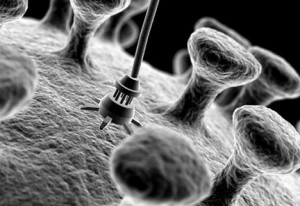 Nanotechnology is the engineering of tiny particles, systems or machines. A nanometer is one-billionth of a meter, or about the width of three or four atoms. Scientists are developing machines so small that the naked human eye cannot see them.
Nanotechnology is the engineering of tiny particles, systems or machines. A nanometer is one-billionth of a meter, or about the width of three or four atoms. Scientists are developing machines so small that the naked human eye cannot see them.
The theoretical possibilities of nanotechnology were first envisioned in 1959 by renowned physicist Richard Feynman. The word nanotechnology was popularized in the 1980’s by K. Eric Drexler. The US National Nanotechnology Initiative was created to fund nanotechnology research.
These tiny machines can be used to build other tiny machines or to perform any purpose desired. Such tiny creations are already in use today and have been for some time. Here is how many experts describe the development timeline:
(a) 1st Generation Passive Nanostructures (2000)
Dispersed and contact nanostructures (aerosols, colloids, coatings)
(b) 2nd Generation Active Nanostructures (2005)
Bio-active and health-related (targeted drugs, biodevices)
(c) 3rd Generation Systems of Nanosystems (2010)
Assembling and networking mechanical systems (robotics)
(d) 4th Generation Molecular Nanosystems (2015-2020)
Designed atomic structures (Independent systems)
Nanosystems can be used for any imaginable purpose. Perhaps unfortunately, that includes military uses. Any military use could also become a terrorist threat, if this technology falls into the wrong hands. However, military use may become necessary if terrorists obtain the technology from a country other than the US. Just as medicines and life-saving procedures can be delivered by nanosystems, so can biological weapons and other destructive nanosystems.
The possibilities of nanosystems sound like something from a comic book or science fiction movie. Small machines that can be injected into the human body to produce a necessary drug or hormone are not out of the question. Microscopic machines that can perform detailed microsurgery procedures without cutting the skin are already being developed.
The Center for Responsible Nanotechnology is working to design and promote mechanisms for safe development and effective administration of molecular manufacturing. As with any emerging technology, it is difficult to govern something that has never been done before, yet as new technologies develop, systems to control them develop as well. It seems that necessity speeds the processes on all levels.
Imagine a tiny nanosystem that could produce insulin within the body after being injected by a very small needle. Insulin-dependent diabetes would be a worry of the past. Perhaps an antibody-producing nanosystem that eliminates minor illnesses is more to your liking. Or a nanosystem that hunts and kills cancer cells without chemo-therapy or radiation. All of this and more is possible through nanotechnology.
Likewise, tiny killing machines and bio-weapons nanosystems are possible. Once again we find the human race on the verge of amazing advancements that could improve the entire human condition or destroy the entire human race. This is not a new situation for us.
The discovery of nuclear energy has been both a blessing and a curse. Nuclear power plants are capable of producing enormous amounts of electrical energy or create bombs that could destroy everything we know. Advanced medical discoveries have produced amazing new medicines that can improve a person’s way of life or be abused and ruin lives.
The end result will depend on the decisions we make as the human race. There will always be those who work to subvert and distort the intended use of an invention or discovery, yet we cannot stop working for new discoveries, for it is the lifeblood of human nature. We will always want to find ways to improve our lives and the lives of others.
As with anything else, there will be risks of opportunities and threats of danger involved with nanotechnology. However, can we really stand in the way of discoveries that could very well lengthen and even save our very lives?





















